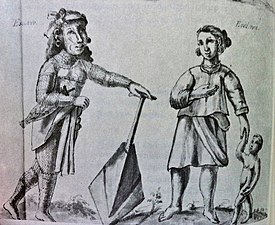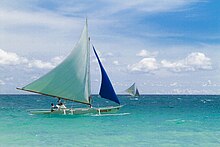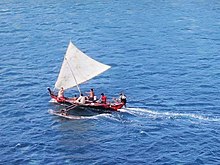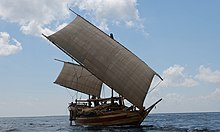Daramba
Daramba is a Visayan term referring to paddling and fighting platforms mounted directly on the outriggers (katig) of traditional large trimaran warships (balangay) of the Philippines. They accommodated one or more rows on each side of commoner warriors (horo-han) with large leaf-shaped paddles (bugsay) during travel, naval warfare, and seasonal coastal raids (mangayaw). The paddlers were kept in rhythm by various chants and songs. The platforms for the horo-han are distinguished from the side-mounted fighting platforms (pagguray) of the warrior-nobility (the timawa and tumao), which were also built on the outriggers, in that the daramba is mounted on or near the water surface, while the pagguray is mounted above, closer to the hull.[1][2][3][4][5]
-
18th-century engraving of a karakoa from The Discovery and Conquest of the Molucco and Philippine Islands (1711) by Bartolomé Leonardo de Argensola, showing two pairs of daramba on each side[6]
See also
References
- ^ Patricia Calzo Vega (1 June 2011). "The World of Amaya: Unleashing the Karakoa". GMA News Online. Retrieved 4 May 2018.
- ^ Emma Helen Blair & James Alexander Robertson, ed. (1906). The Philippine Islands, 1493-1898.
- ^ Scott, William Henry (1982). "Boat-Building and Seamanship in Classic Philippine Society" (PDF). Philippine Studies. 30 (3): 335–376. JSTOR 42632616.
- ^ Stead, Martin Roderick (2018). Defining the Construction Characteristics of Indigenous Boats of the Philippines: The Impact of Technical Change Pre and Post Colonisation (PDF) (MPhil). University of Southampton.
- ^ de Méntrida, Alonso (1637). Vocavulario de Lengua Bisaya, Hiligaina y Haraya de la Isla de Panay Y Sugbu y Para Las Demás Islas (PDF).
- ^ Bartolomé Leonardo de Argensola (1711). "The Discovery and Conquest of the Molucco and Philippine Islands.". In John Stevens (ed.). A New Collection of Voyages and Travels, into several Parts of the World, none of them ever before Printed in English. p. 61.

![18th-century engraving of a karakoa from The Discovery and Conquest of the Molucco and Philippine Islands (1711) by Bartolomé Leonardo de Argensola, showing two pairs of daramba on each side[6]](http://upload.wikimedia.org/wikipedia/commons/thumb/0/0b/Caracoa_%28Karakoa%29.jpg/332px-Caracoa_%28Karakoa%29.jpg)





